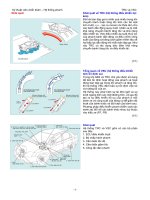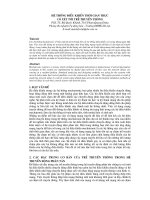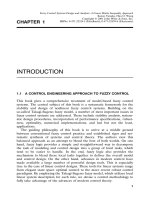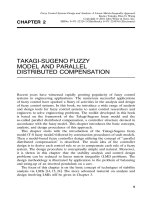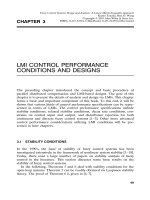Tài liệu Hệ thống điều khiển mờ - Thiết kế và phân tích P12 docx
Bạn đang xem bản rút gọn của tài liệu. Xem và tải ngay bản đầy đủ của tài liệu tại đây (220.66 KB, 29 trang )
Fuzzy Control Systems Design and Analysis: A Linear Matrix Inequality Approach
Kazuo Tanaka, Hua O. Wang
Copyright ᮊ 2001 John Wiley & Sons, Inc.
Ž. Ž .
ISBNs: 0-471-32324-1 Hardback ; 0-471-22459-6 Electronic
CHAPTER 12
NEW STABILITY CONDITIONS AND
DYNAMIC FEEDBACK DESIGNS
This chapter presents a unified systematic framework of control synthesis
wx
1᎐5 for dynamic systems described by the Takagi-Sugeno fuzzy model. In
comparison with preceding chapters, this chapter provides two significant
extensions. First we provide a new sufficient condition for the existence of a
quadratically stabilizing state feedback PDC controller which is more general
and relaxed than the existing conditions. Second, we introduce the notion of
Ž.
dynamic parallel distributed compensation DPDC and we provide a set of
sufficient LMI conditions for the existence of quadratically stabilizing dy-
namic compensators.
In this chapter, the notation M ) 0 stands for a positive definite symmet-
Ž.
TT n=n
ric matrix M;
L
L
A, P s AP q PA is defined as a mapping from ᑬ
n=nn=n
Ž
TT
.
TT
= ᑬ to ᑬ . The same holds for
L
L
A , Q s AQ q QA. The term
yT
Ž
y1
.
T
P is the same as P . From this chapter onward, we will use italic
symbols such as A and B instead of A and B.Inaddition, to lighten the
Ž. Ž. Ž. Ž.
notation, we will use x, y, z, p, and u instead of x t , y t , z t , p t , and
Ž.
u t , respectively. Another notable point regarding the notation is that we
Ž. Ž.
will use pt or p instead of zt as premise variables. This is because z is
used as performance variables in Chapters 13 and 15 which are based on the
setting presented in this chapter. The symbol x
X
denotes the transposed
vector of x.Weoften drop the p and just write h , but it should be kept in
i
mind that the h ’s are functions of the variable p.
i
The summation process associated with the center of gravity defuzzifica-
Ž. Ž.
tion in system 2.3 and 2.4 can also be viewed as an interpolation between
the vectors Axq Bubased on the value of the parameter p. The parameter
ii
p can be given several different interpretations. First, we can assume that the
229
NEW STABILITY CONDITIONS AND DYNAMIC FEEDBACK DESIGN
230
parameter p is a measurable external disturbance signal which does not
Ž. Ž.
depend on the state or control input of the system 2.3 and 2.4 . Using this
Ž. Ž.
interpretation, equations 2.3 and 2.4 describe a time-varying linear system.
Second, we can assume that the parameter p is a function of the state,
Ž. Ž. Ž.
p s fx. Using this interpretation, equations 2.3 and 2.4 describe a
nonlinear system. As a slight modification to this interpretation, we can
assume that the parameter p is a function of the measurable outputs of the
Ž.
system, p s fy. Finally, we can assume that p is an unknown constant
Ž. Ž.
value, in which case equations 2.3 and 2.4 describe a linear differential
Ž.
inclusion LDI . In most cases, we can only derive a benefit from the fuzzy
rule base description if we know the values of the parameters, so we will
not usually consider this last interpretation. It is also possible to interpret
p using a combination of these approaches.
12.1 QUADRATIC STABILIZABILITY USING
STATE FEEDBACK PDC
In this section, we consider the special form of parameter-dependent state
feedback which mirrors the structure of the T-S model, that is, parallel
Ž.wx
distributed compensation PDC 19, 20
The PDC controller structure consists of fuzzy rules:
Control Rule i
Ž. Ž.
IF ptis M иии and ptis M ,
11ilil
Ž. Ž.
THEN ut s Kxt,
i
where i s 1,2,...,r. The output of the PDC controller is
r
u s hKx.12.1
Ž.
Ý
ii
i
s1
Remark 37 Note that the notation for PDC here is in slightly different form
from earlier chapters where the PDC controller is of the following form
r
u sy hFx.12.2
Ž.
Ý
ii
i
s1
Ž.
X
Let us consider the Lyapunov function candidate Vxs xPx, where
P ) 0. Taking the time derivative of this function along the flow of
QUADRATIC STABILIZABILITY USING STATE FEEDBACK PDC
231
the system,
rr
d
X
TT
Vxs hhx
L
L
A , P q KBPq PB K x 12.3
Ž. Ž . Ž .
Ž.
ÝÝ
ij i j i i j
dt
i
s1 js1
rr
1
X
TT
s hhx
L
L
A q A , P q KBP
Ž.
Ž
ÝÝ
ij i j j i
2
i
s1 js1
qPB K q K
T
B
T
P q PB K x.12.4
Ž.
.
ij ij ji
If for each 1 F i F j F r there exists a symmetric n = n matrix T s T
T
ij ij
such that
L
L
A q A , P q K
T
B
T
P q PB K q K
T
B
T
P q PB K - T , ᭙ , ᭙
Ž.
ij ji ijij jiijij
12.5
Ž.
and
T иии T
11 1 r
..
.
...
T s - 0, 12.6
Ž.
.
..
T иии T
1 rrr
then
rr
d
X
Vx- hhxT x
Ž.
ÝÝ
ij ij
dt
i
s1 js1
T
XXXX
wxwx
s hx ... hx T hx ... hx
1 r 1 r
- 0.
In order to express these inequalities as LMI conditions, we need to use a
y1
ˆ
transformation. Define Q s P , T s QT Q, and M s KQ. Pre- and
ij ij i i
Ž.
postmultiplying equation 12.5 by Q produces the expression
TT TT TT
ˆ
L
L
A q A , Q q MBq BMq MBq BM-T ,
Ž.
ij jiijijjiij
i F j s.t. h l h / or.12.7
Ž.
ij
We also know that T - 0 if and only if
ˆˆ
T иии T
11 1 r
..
.
...
ˆ
T s - 0. 12.8
Ž.
.
..
ˆˆ
T иии T
1 rrr
The resulting LMI conditions are summarized in the following theorem:
NEW STABILITY CONDITIONS AND DYNAMIC FEEDBACK DESIGN
232
Ž.
THEOREM 45 The T-S model 2.3 is quadratically stabilizable in the large
Ž.
®ia a state feedback PDC controller 12.1 if there exist Q ) 0, M , i s 1,2,...,r,
i
ˆ
Ž. Ž.
and T such that the LMI conditions 12.7 and 12.8 ha®e feasible solutions.
ij
The ith gain of the PDC controller is gi®en by
K s MQ
y1
12.9
Ž.
ii
and the Lyapuno® function is gi®en by
V s x
T
Q
y1
x. 12.10
Ž.
Remark 38 The above theorem is a generalization of the stability condition
wx wx wx
given in 17 and 20 . It is also weaker than the LMI condition given in 25 ,
in which case T becomes tI. The above theorem can be further relaxed if
ij ij
we know the structure of the fuzzy membership function:
ⅷ
Sometimes there is no overlap between two rules, that is, the product of
the h and the h may be identically zero. In this case, the above
ij
Ž.
theorem can be relaxed by dropping the condition 12.7 corresponding
Ž.
to the i and j in 12.7 .
ⅷ
If only s - r rules can fire at the same time, then the conditions of this
theorem can be further relaxed to only require that all the diagonal
s = s principal submatrices of T are negative definite.
12.2 DYNAMIC FEEDBACK CONTROLLERS
In this section we introduce the concept of a DPDC, and we derive a set of
LMI conditions which can be used to design a stabilizing DPDC.
In order to derive the LMI design conditions, it is useful to begin with a
parameter-dependent linear model described by the equations
xts Apxtq Bput,
Ž. Ž . Ž. Ž . Ž.
˙
yts Cpxt, 12.11
Ž. Ž . Ž. Ž .
Ž. Ž. Ž.
where xt, yt, and ut denote the state, measurement, and input vectors,
Ž.
respectively. The variable pt is a vector of measurable parameters. In
general, these parameters may be functions of the system states, external
disturbances, and time. Note that the T-S model is in this form.
A parameter-dependent dynamic compensator is a parameter-dependent
linear system of the form
xts Apxtq Bpyt,
Ž. Ž . Ž. Ž . Ž.
˙
cccc
ut s Cpxtq Dpyt. 12.12
Ž. Ž . Ž. Ž . Ž. Ž .
cc c
DYNAMIC FEEDBACK CONTROLLERS
233
Defining the augmented system matrix
Apq BpD pCp BpC p
Ž. Ž. Ž.Ž. Ž. Ž.
cc
Aps
Ž.
cl
BpCp Ap
Ž.Ž. Ž.
cc
and the augmented state vector
T
TT
xts xt xt ,
Ž. Ž. Ž.
cl c
the resulting closed-loop dynamic equations are described by the equation
xts Apxt. 12.13
Ž. Ž . Ž. Ž .
˙
cl cl cl
Ž.
The system 12.11 is said to be quadratically stabilizable via an s-dimen-
sional parameter-dependent linear compensator if and only if there exists an
s-dimensional parameter-dependent controller and a positive definite matrix
P ) 0 such that
cl
PA pq A
T
pP- 0. 12.14
Ž. Ž. Ž .
cl cl cl cl
Ž.
Remark 39 If we fix the value of p, equation 12.14 represents a sufficient
condition for the existence of a set of linear, time-invariant controller
Ž. Ž. Ž. Ž. Ž .
matrices Ap, Bp, Cp, and Dpwhich will stabilize the system 2.3
ccc c
Ž.
and 2.4 at the fixed value of p. The unknown controller does not enter
Ž.
linearly into equation 12.14 , so this equation does not represent an LMI
wx
condition. However, the authors of the paper 14 present a transformation
procedure which results in a modified set of inequalities which are linear in
the unknown data. In what follows, we perform this transformation pointwise
with respect to p.
We will first partition the constant matrices P and P
y1
into components:
PP
11 12
P s
cl
T
PP
12 22
and
11 12
y1
P s ,
cl
T
12 22
and we will also define the matrices
QI
11
⌸ s
1
T
Q 0
12
and
IP
11
⌸ s P ⌸ s .
2 cl 1
T
0 P
12
NEW STABILITY CONDITIONS AND DYNAMIC FEEDBACK DESIGN
234
Ž.
Equation 12.14 will hold if and only if
⌸
T
PA p⌸ q ⌸
T
A
T
pP⌸ - 0.
Ž. Ž.
1 cl cl 11cl cl 1
This equation can also be rewritten as
⌸
T
Ap⌸ q ⌸
T
A
T
p ⌸ - 0.
Ž. Ž.
2 cl 11cl 2
Writing out the first term on the left-hand side of this equation, we have
I 0 Apq BpD pCp BpC p Q I
Ž. Ž. Ž.Ž. Ž. Ž.
Ž.
cc11
T
PP BpCp Ap Q0
Ž.Ž. Ž.
11 12 cc12
s Ep.
Ž.
If we define the new variables
A
A
p s PApq BpD pCp Q q PB pCpQ
Ž. Ž. Ž. Ž.Ž. Ž.Ž.
Ž.
11 c 11 12 c 11
q PBpC pQ
T
q PApQ
T
,
Ž. Ž. Ž.
11 c 12 12 c 12
B
B
p s PBpD pq PB p,
Ž. Ž. Ž. Ž.
11 c 12 c
C
C
p s DpCpQq CpQ
T
,
Ž. Ž.Ž. Ž.
c 11 c 12
D
D
p s Dp,
Ž. Ž.
c
Ž.
then the matrix Epcan be rewritten as
ApQ q Bp
C
C
pApq Bp
D
D
pC p
Ž. Ž.Ž. Ž. Ž. Ž.Ž.
11
Eps ,
Ž.
A
A
pPApq
B
B
pCp
Ž. Ž. Ž. Ž.
11
and the closed-loop stability condition can be expressed as
Epq E
T
p - 0
Ž. Ž.
or
T
Ž.
Ap
Ž.
L
L
Ap, Q
Ž.
11
T
T
ž/
T
ž/
Ž. Ž.Ž. Ž.
qBp
D
D
pC p q
A
A
p
Ž. Ž. Ž. Ž.
qBp
C
C
p q
C
C
pB p
- 0
T
Ž.
L
L
Ap, P
Ž.
Ž. Ž.
A
A
p q Ap
11
T
T
TT
T
ž/
ž/
Ž. Ž. Ž.
qCp
D
D
pB p
Ž.Ž. Ž. Ž.
q
B
B
pC p q Cp
B
B
p
together with the constraint that
P ) 0.
cl
DYNAMIC FEEDBACK CONTROLLERS
235
This last condition holds if and only if
⌸
T
P ⌸ ) 0,
1 cl 1
or
I 0 QI
11
T
⌸⌸s 12.15
Ž.
21
T
PP Q0
11 12 12
QI
11
s ) 0. 12.16
Ž.
IP
11
We also have the constraint that
PQ q PQ
T
s I. 12.17
Ž.
11 11 12 12
We will now assume that the parameter-dependent plant can be described
by a fuzzy T-S model using r model rules. In this case, the parameter-depen-
dent plant can be described by the equation
r
Ap Bp A B
Ž. Ž.
ii
s hp ,
Ž.
Ý
i
Cp 0 C 0
Ž.
i
i
s1
Ž.
where hpsatisfies the normalization condition,
r
hpG 0 and hps 1.
Ž. Ž.
Ý
ii
i
s1
Ž.
The matrix Epcan be written as
Ep Ep
Ž. Ž.
11 12
E s , 12.18
Ž.
Ep Ep
Ž. Ž.
21 22
where
rr
Eps hphp Aq BD p C Q
Ž. Ž. Ž. Ž.
Ž.
ÝÝ
Ž
11 ij iicj11
i
s1 js1
qBC p Q
T
, 12.19
Ž. Ž .
.
ic 12
rr
Eps hphp Aq BD p C , 12.20
Ž. Ž. Ž. Ž. Ž .
Ž.
ÝÝ
12 ij iicj
i
s1 js1
rr
Eps hphpP Aq BD p C Q
Ž. Ž. Ž. Ž.
Ž.
ÝÝ
Ž
21 ij 11 iic j11
i
s1 js1
qPB pCQq PBC pQ
T
Ž. Ž.
12 ci11 11 ic 12
qPA pQ
T
, 12.21
Ž. Ž .
.
12 c 12
NEW STABILITY CONDITIONS AND DYNAMIC FEEDBACK DESIGN
236
rr
Eps hphp P Aq BD p C
Ž. Ž. Ž. Ž.
Ž.
ÝÝ
Ž
22 ij 11 iic j
i
s1 js1
qPB pC. 12.22
Ž. Ž .
.
12 ci
We are now ready to introduce dynamic parallel distributed compensators
for this system. In general, a DPDC can have cubic, quadratic, or linear
parameterization. For a given T-S model, the choice of a particular DPDC
parameterization will be influenced by the structure of the T-S subsystems. In
the following subsections, we discuss each of these three parameterizations.
12.2.1 Cubic Parameterization
Controller Synthesis. In this section, we will assume that the controller has
the form
rr r
ijk
xts hphph pAxt
Ž. Ž. Ž. Ž. Ž.
˙
ÝÝÝ
cijkcc
i
s1 js1 ks1
rr
ij
q hphpByt, 12.23
Ž. Ž. Ž. Ž .
ÝÝ
ijc
i
s1 js1
rr r
ij i
ut s hphpCxtq hpDyt, 12.24
Ž. Ž. Ž. Ž. Ž. Ž. Ž .
ÝÝ Ý
ijcc i c
i
s1 js1 is1
or equivalently that
rrr
ijk
Aps hphph pA, 12.25
Ž. Ž. Ž. Ž. Ž .
ÝÝÝ
cijkc
i
s1 js1 is1
rr
ij
Bps hphpB, 12.26
Ž. Ž. Ž. Ž .
ÝÝ
cijc
i
s1 js1
rr
ij
Cps hphpC, 12.27
Ž. Ž. Ž. Ž .
ÝÝ
cijc
i
s1 js1
r
i
Dps hpD. 12.28
Ž. Ž. Ž .
Ý
cic
i
s1
Using this controller form, we can rewrite the equations for the matrix
DYNAMIC FEEDBACK CONTROLLERS
237
Ž.
Epas
rr r
Eps hphph p
Ž. Ž. Ž. Ž.
ÝÝÝ
11 ijk
i
s1 js1 ks1
= A q BD
j
CQq BC
jk
Q
T
, 12.29
Ž.
Ž.
Ž.
iick11 ic 12
rr r
j
Eps hphph p Aq BDC , 12.30
Ž. Ž. Ž. Ž. Ž .
Ž.
ÝÝÝ
12 ijk iick
i
s1 js1 ks1
rr r
j
Eps hphph pP Aq BDC Q
Ž. Ž. Ž. Ž.
Ž.
Ž
ÝÝÝ
21 ijk 11 iick11
i
s1 js1 ks1
qPB
ij
CQ q PBC
jk
Q
T
q PA
ijk
Q
T
, 12.31
Ž.
.
12 ck11 11 ic 12 12 c 12
rr r
Eps hphph p
Ž. Ž. Ž. Ž.
ÝÝÝ
22 ijk
i
s1 js1 ks1
= PAq BD
j
C q PB
ij
C , 12.32
Ž.
Ž.
Ž.
11 iick 12 ck
and we have that
rr r
A
A
p s hphph p
A
A
Ž. Ž. Ž. Ž.
ÝÝÝ
ijk
ijk
i
s1 js1 ks1
rr r
j
J hphph pP Aq BDC Q
Ž. Ž. Ž.
Ž.
Ž
ÝÝÝ
ijk 11 iick11
i
s1 js1 ks1
qPB
ij
CQ q PBC
jk
Q
T
q PA
ijk
Q
T
,
.
12 ck11 11 ic 12 12 c 12
rr
B
B
p s hphp
B
B
Ž. Ž. Ž.
ÝÝ
ij
ij
i
s1 js1
rr
jij
J hphpPBDq PB ,
Ž. Ž.
Ž.
ÝÝ
ij 11 ic 12 c
i
s1 js1
rr
C
C
p s hphp
C
C
Ž. Ž. Ž.
ÝÝ
ij
ij
i
s1 js1
rr
iijT
J hphpDCQq CQ ,
Ž. Ž.
Ž.
ÝÝ
ij cj11 c 12
i
s1 js1
r
D
D
p s hp
D
D
Ž. Ž.
Ý
i
i
i
s1
r
i
J hpD.
Ž.
Ý
ic
i
s1
NEW STABILITY CONDITIONS AND DYNAMIC FEEDBACK DESIGN
238
Ž.
The matrix Epthen becomes
rr r
Eps hphph pE
Ž. Ž. Ž. Ž.
ÝÝÝ
ijk ijk
i
s1 js1 ks1
rr r
s hphph p
Ž. Ž. Ž.
ÝÝÝ
ijk
i
s1 js1 ks1
=
AQ q B
C
C
A q B
D
D
C
i 11 iiik
jk j
. 12.33
Ž.
A
A
PAq
B
B
C
11 ik
ijk ij
The closed-loop stability condition then becomes
rr r
hphph p
Ž. Ž. Ž.
ÝÝÝ
ijk
i
s1 js1 ks1
TT
TT
L
L
A , Q q B
C
C
q
C
C
BAq B
D
D
C q
A
A
Ž.
i
11 iiiik
jk jk j i jk
=-0. 12.34
Ž.
T
T
T
Ž.
A
A
q A q B
D
D
C
L
L
A , P q
B
B
C q C
B
B
Ž.
ii k i
11 kk
ijk j ij ij
So the system will be stable if the following LMI holds.
TT
TT
L
L
A , Q q B
C
C
q
C
C
BAq B
D
D
C q
A
A
Ž.
i
11 iiiik
jk jk j i jk
- 0,
T
T
T
Ž.
A
A
q A q B
D
D
C
L
L
A , P q
B
B
C q C
B
B
Ž.
ii k i
11 kk
ijk j ij ij
᭙i, j, k. 12.35
Ž.
Ž. Ž.
THEOREM 46 The T-S model 2.3 and 2.4 is globally quadratically stabi-
Ž.Ž. Ž.
lizable ®ia a DPDC controller 12.25 ᎐ 12.28 if the LMI conditions 12.16 and
Ž.
12.35 are feasible with LMI ®ariables Q , P ,
A
A
,
B
B
,
C
C
, and
D
D
. The
11 11
ijk ij jk j
controller is gi®en by
A
ijk
s P
y1
A
A
y PB
c
CQ y PBC
c
Q
T
ž
c 12 12 ij k 11 11 ijk 12
ijk
yPAq BD
c
CQ Q
y1
, 12.36
Ž.
Ž.
/
11 iijk11 12
B
ij
s P
y1
B
B
y PBD
c
, 12.37
Ž.
ž/
c 12 11 ij
ij
C
ij
s
C
C
y D
c
CQ Q
yT
, 12.38
Ž.
ž/
cij11 12
ij
D
i
s
D
D
, 12.39
Ž.
c
i
where P , P , Q , and Q satisfy the constraint P Q q PQ
T
s I.
11 12 11 12 11 11 12 12
DYNAMIC FEEDBACK CONTROLLERS
239
Ž.
Reduction of LMI Equations 12.34 can be simplified by permuting in-
dices. To this end, we first note that the controller equations can be rewritten
as
r
3 iii
Aps hpA
Ž. Ž.
Ý
cic
i
s1
r
1
2 ii j i ji jii
q 3hphp Aq A q A
Ž. Ž.
Ž.
ÝÝ
ij ccc
3
i
s1 j-i
r
1
2 ijj jij jji
q 3hphp Aq A q A
Ž. Ž.
Ž.
ÝÝ
ji ccc
3
i
s1 j-i
r
q 6hphph p
Ž. Ž. Ž.
ÝÝÝ
ijk
i
s1 j-ik-j
=
1
ijk ikj jik jki kij kji
A q A q A q A q A q A ,
Ž.
cccccc
6
r
2 ii
Bps hpB
Ž. Ž.
Ý
cic
i
s1
r
1
ij ji
q 2 hphp Bq B ,
Ž. Ž.
Ž.
ÝÝ
ij cc
2
i
s1 j-i
r
2 ii
Cps hpC
Ž. Ž.
Ý
cic
i
s1
r
1
ij ji
q 2 hphp Cq C ,
Ž. Ž.
Ž.
ÝÝ
ij cc
2
i
s1 j-i
r
i
Dps hpD.
Ž. Ž.
Ý
cic
i
s1
From these equations, we can define an ‘‘average’’ set of vertex variables
1
ijk ijk ikj jik jki kij kji
A s A q A q A q A q A q A , 12.40
Ž.
Ž.
ccccccc
6
1
ij ij ji
B s B q B , 12.41
Ž.
Ž.
ccc
2
1
ij ij ji
C s C q C , 12.42
Ž.
Ž.
ccc
2
ii
D s D . 12.43
Ž.
cc
